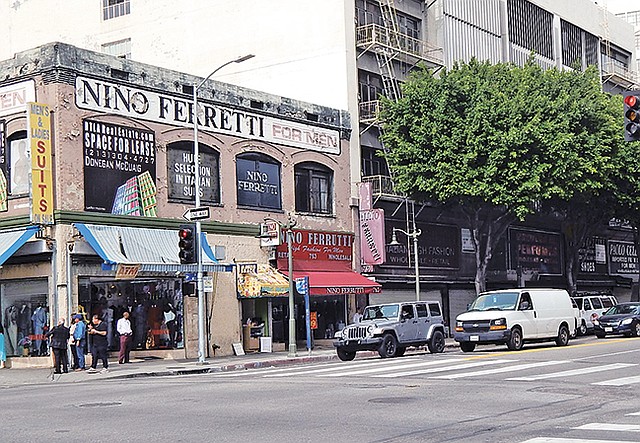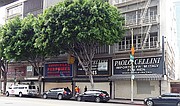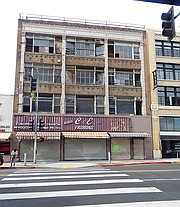Changes on the Fashion District’s Los Angeles Street
Changing Los Angeles Street
As of Thursday, May 2, 2019
Renovation in the Los Angeles Fashion District is hitting high gear as the mammoth Broadway Plaza apartment complex on Broadway is getting ready to open and a major lease has been signed at the hip retail complex called Row DTLA, which is located just outside the district.
The area is experiencing a resurgence in major corporate players, such as Adidas, which reportedly inked a deal to rent 31,000 square feet of office space at the industrial complex that sits next to the old American Apparel factory on Alameda Street. Spotify, the digital website that lets you stream music, is moving from West Hollywood, Calif., and considering setting up offices in the same part of the neighborhood.
“When you look at something like the Row, the building sat vacant for many, many years,” said Mark Chatoff, president of the California Flower Mall Inc. “The Row has been something that has been underutilized. The whole area has been underutilized, and it’s fascinating to see what is going on.”
What’s going on is a redevelopment evolution of a neighborhood forgotten for decades by mainstream companies. As the Fashion District changes, however, there are certain areas where the transformation is affecting many tried-and-true retailers who have been in the Fashion District for years.
One of those areas is Los Angeles Street, home to long-established menswear retailers that have sold fancy suits and matching ties to generations of prom attendees, wedding parties and churchgoers. After receiving a $1.5-million Metropolitan Transportation Authority grant and contributing $50,000, the LA Fashion District Business Improvement District spent $2 million to upgrade 13,000 square feet of sidewalks, create curbs with pocket gardens and add 27 flowering pear trees protected by cast-iron grates.
A walk down the street between Fifth Street and Olympic Boulevard revealed several gated storefronts advertising space for lease.
One menswear business owner located on Los Angeles Street, who did not wish to be identified, expressed his disappointment that his landlord gave him only 30 days’ notice to sell his inventory and vacate the retail space he had occupied for 22 years. “As a courtesy, it would have been helpful if he said, ‘You have to go. You’ve been my tenant, but I have to make money because I am a landlord. I’ll give you four months, get ready,’” he explained. “No problem. I am a businessman.”
Nino Ferrutti, a Los Angeles Street menswear store now at 763 S. Los Angeles St., ended up moving one door away. “We used to be next door, but they sold the building, and we had to move here. They’re going to make the bottom [of our old building] a food court,” said Nick Fargam, who recently left Nino Ferrutti. “They are going to change downtown to make it the same as New York. It’s a good idea, but it takes time.”
One building that is now shuttered is the former C&E Fashions store at 823 S. Los Angeles St., located between Eighth and Ninth Streets. There are plans to convert the former manufacturing facility, built in 1920, to 12 live-work apartment spaces. The four-story building will retain its ground-floor commercial area.
But landlords said they are trying to be fair. As a property owner whose family has owned buildings for three generations on Los Angeles Street, Laurie Sale of the SCS Building Fund LLC explained that higher rent prices are a byproduct of the redevelopment process. As taxes rise and maintenance costs increase, a slight hike in rent is to be expected. While considering their own needs, she explained how contributing to the neighborhood growth, while remaining fair to tenants, is a priority for landlords in the area.
“The property owners that I know along Los Angeles Street have been very accommodating to make sure that nobody is forced to make a change,” she said. “If a lot of money is being put into redevelopment, the landlord has to be able to recoup some of that.”
Most of her tenants that occupy spaces on Los Angeles Street are men’s apparel businesses and have been in her buildings between 12 and 25 years. They have remained with Sale throughout the change in the neighborhood.
When asked about the menswear store closures along Los Angeles Street, Councilmember Jose Huizar, whose District 14 includes the Fashion District, said he wasn’t aware of the issue but advised that communication between property owners and tenants yielded progress on other streets.
“What we have done in other areas for example is that we had a comprehensive approach that we got together with local businesses. For example, on Broadway, we talked about the challenges of being there with the rising cost of rent,” he said at a May 24 meeting of Fashion District BID stakeholders. “It was more about exchange of information. ‘What are your expectations?’ ‘What are our expectations?’ ‘How do you see this group moving forward?’”
Huizar said he would be interested in developing incentives for landowners to maintain their relationships with long-term tenants, which would make store closures the exception rather than the rule.
“In Boyle Heights, we’re looking to see how we can provide incentives for property owners to give long-term leases to tenant businesses who have been there for a long time so that they don’t get displaced,” he said. “What type of incentives are those? Perhaps we do façade improvements for them, work on energy efficiency with them—a free efficiency plan and implement those for them.”
These efforts are part of the progress that Sale supports, as she believes these improvements can help not only her real-estate interests but also her tenants’ businesses. While she is excited about these changes, Sale also emphasized that the efforts to improve the district must be collaborative.
“We got our streets redone. We got those nice sidewalks with the landscaping,” Sale explained. “People are trying to change it in other ways to make it more welcoming. When our buildings and our area look better, our tenants do better. That’s just economics 101. You all have to work together.”



